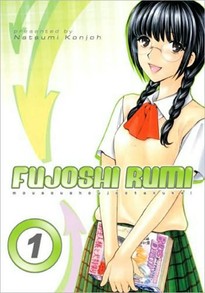Review
by Casey Brienza,Fujoshi Rumi
GN 1-2
| Synopsis: |  |
||
Love ain't easy when the object of your affections is a fujoshi. Takahiro Abe is a (painfully) ordinary high school boy who agrees to model for the adorable Rumi Asai…who, as it turns out, is a die-hard fujoshi who wants his body for her, ahem, yaoi doujinshi. Soon enough, he is smitten and determined to learn his beloved's ways. Later on, the duo is joined by Takahiro's boyhood friend, the playboy Shunsuke Chiba, and the glamorous Yasuko Matsuura, a second fujoshi forever. Shunsuke, if he is capable of feeling anything, also has his heart set on Rumi, while Yasuko has long harbored a crush on Shunsuke. Together, the quartet navigates the rocky waters between the Lands of Ordinary and Otaku. Can even their love build bridges? |
|||
| Review: | |||
During Japan's decade-long economic slump, the otaku and his consumer obsessions were the only things keeping the wheels of commerce turning…or so say the otaku themselves, at least. Regardless of the truth behind the matter, this received wisdom has become a self-fulfilling prophecy of sorts as Japan's otaku tribe has been transformed into just another market demographic for whom various companies and institutions hotly compete. The world of otakudom has gone mainstream, and the otaku are nobody's secret source of income—not anymore. So it was perhaps inevitable that commercial interest would, at the end of the 20th century, shift toward the otaku's feminine fandom counterpart, the fujoshi (literally “rotten girl”), who was believed—along stereotyped gendered lines, of course—to be less smelly and more sociable than the otaku but nevertheless eager to consume in bulk the myriad products related to her odd obsessions. And sure enough, catering to female tastes in bishounen and BL (boy's love) made people lots of money, and the fujoshi quickly became a cultural force in her own right. After that, it was only a matter of time before the increased visibility would start inspiring manga storylines. Mōsō Shōjo Otaku Kei, retitled Fujoshi Rumi for release in the United States by Media Blasters with the permission of mangaka Natsumi Konjoh, is among the most prominent of this first wave of fujoshi-centric efforts. What it is not, unfortunately, is a terribly realistic or convincing one. The characters are, paradoxically, the manga's weakest point. While Rumi, Yasuko, and Shunsuke's sister in volume two are believable as fujoshi, clearly based upon Konjoh's own experiences, they have no real identity apart from their fandom. The guys are even less well-described; Takahiro is the male equivalent of the naïve shoujo heroine, and Shunsuke is just habitually insincere. Some of the problem may stem from the publisher. Fujoshi Rumi runs in Futabasha's Comic High!, which specializes in “shoujo manga for men.” But how, exactly, does one go about writing shoujo manga for men? There isn't much precedent for it, and the series seems uncomfortable in its own skin. For example, in the first volume, the first chapter is narrated from Rumi's point of view, but then the rest is told from Takahiro's. In the second volume, narrative perspective ricochets from one character to the next and back again from chapter to chapter. Who is supposed to be the object of the proverbial gaze here, and who the subject? Even after two volumes, the answer to these questions are not resolved, and thus what should be full-throttle and exaggerated instead feels tentative and lukewarm. Konjoh's art is distinctively shoujo and feminine with its ectomorphic characters and stiffly-plotted sequences, and the occasional BL/yaoi illustration looks cut and pasted from the latest issue of BexBoy. But her male-centric fanservice is barely serviceable, and the obligatory bouncing boobs and lesbian jokes are treated like a gross chore. Plotting is likewise uneven. The first volume is comprised mostly of introductory chapters of below average effort, though there is a subplot at the end involving Takahiro's first visit to Rumi's house. The second volume does show some improvement—albeit not enough—and the quartet's expedition to a thinly-disguised summer Comic Market is the highlight of the series thus far. But although a Comiket visit is key to the anthropological study of the otaku in its native habitat, those not familiar with otaku culture should use caution when approaching Fujoshi Rumi. It is most effective as parody, and there are countless insider references to mid 90s – early 00s anime/manga series such as Gundam, Evangelion, and Death Note...not to mention the amusing amalgamation of Fullmetal Alchemist, Prince of Tennis, and Loveless called “Fullmetal Prince.” Media Blasters provides six pages of endnotes, which are quite educational, explaining all of these arcane references at the end of each volume. However, humor that has to be explained isn't funny, and you are unlikely to fully appreciate these books unless you're already a card-carrying otaku able to recognize most of the references without assistance (and squeal along). Ironically, more effort appears to have been put into the execution of the footnotes than that of the translation itself. There are a number of typos in the first volume, and several text boxes and balloons are missing words in the second. These editorial bloopers didn't bother me overmuch and did not particularly interfere with overall reading comprehension, but they were definitely noticeable. Even so, Fujoshi Rumi is without a doubt one of Media Blasters' best manga releases to date and far and away the best in quite a long time. |
| Grade: | |||
|
Overall : B-
Story : B-
Art : C+
+ Unusual subject matter with an interesting perspective on the female anime fan. |
|||
| discuss this in the forum (14 posts) | | |||
| Production Info: | ||
|
Full encyclopedia details about Release information about |
||